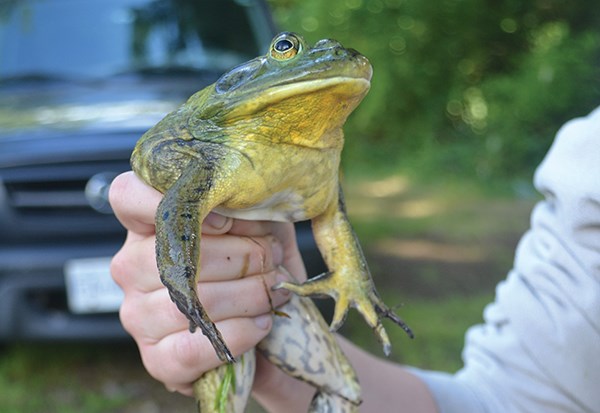With their deep, bellowing call and tendency to eat other animals, American bullfrogs aren’t welcome in Squamish.
The species is native to the eastern part of North America but is quickly spreading throughout the Lower Mainland.
There hasn’t been a confirmed sighting in Squamish yet, but the Sea to Sky Invasive Species Council is keeping a close lookout.
“We had a bit of a scare at Nexen Beach that spurred us to start monitoring the area,” said Rylee Murray, a biological sciences student at Simon Fraser University who made a presentation at the council’s annual general meeting on April 20. A Squamish resident thought he heard the distinctive call of an American bullfrog, but volunteers were unable to locate any in the water.
The closest they have been spotted to Squamish, so far, is in North Vancouver.
The problem with the American bullfrog, like a number of other invasive species, is that it harms the environment by preying on native animals, experts say. Their large mouths allow them to eat birds, small mammals, snakes and other frogs, in addition to the customary frog fare of insects.
Bullfrogs are among the largest and most predatory frogs in B.C. Females, which are a bit larger than males, can grow up to 20 centimetres in length, not including the legs, and weigh 750 grams.
When they colonize a lake, the population of native frogs, such as red-legged frogs and Pacific chorus frogs, tend to decrease, leading to a decline in biodiversity.
The worry is that someone will capture a bullfrog or tadpole somewhere else in the Lower Mainland and bring it to Squamish without knowing the harm.
Bullfrogs were first introduced to B.C. in the early-1900s when they were farmed for their meaty legs. Flooding in the late 1940s caused the frogs to be released into the Fraser Valley, and they have since spread throughout the Lower Mainland, southern Vancouver Island and in the south Okanagan, as well as a number of places where they were introduced in the United States.
“There are thousands and thousands in the Fraser Valley, so you can’t eradicate them there,” said Murray, who visited 70 wetlands in 2012 to study bullfrogs. “If we make an early detection in Squamish, it makes it much easier to eradicate them.
“The young males are often the first to arrive, so it’s best to find them before the females get there.”
If a bullfrog is ever spotted in Squamish, a group of people would go out at night to capture any frogs floating on top of the water, said Murray. They would use flashlights to blind the frogs so they are easy to trap, then euthanize them.
“We will do a call survey again in June or July to see what we can find,” said Clare O’Brien, executive director of the Sea to Sky Invasive Species Council. “We want to deal with it early on if they are spotted here.”
At its annual general meeting, the council discussed the American bullfrog and invasive plants, such as Japanese knotweed and yellow flag iris, that have been spotted in Squamish. These species are among the most worrisome for council members.
The male American bullfrog’s loud call can help distinguish it from other frogs, is most often heard in spring and summer and can carry up to a kilometre from their home, which is typically a shallow pond or lake with a lot of vegetation.
“They have a large, booming call that’s like a fog horn if you’re hearing it far away,” said Murray.
If anyone thinks they hear or see an American bullfrog in the Squamish area, O’Brien recommends reporting it through the council’s website or through www.bcfrogwatch.ca, a government website that tracks frogs in B.C.
The smartphone app, Report-Invasives-BC, is another handy way to identify and report invasive plants and animals. An audio recording or photo along with a description of the location, including GPS coordinates if possible, will help researchers.




